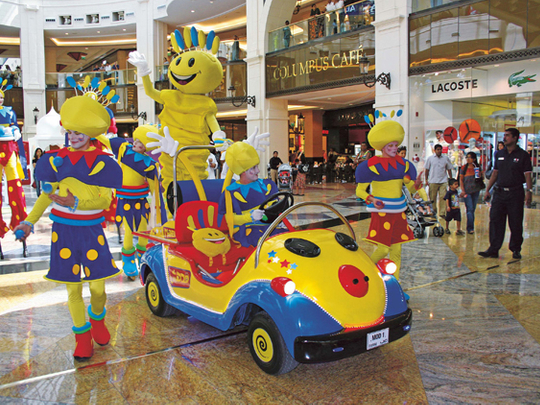
A native of the Arabian Desert, he effortlessly navigates the snow-covered slopes at Ski Dubai, with the swish of a yellow and purple sash. A sunny smiley is his biggest feature and travels easily from cartoons to cartons. He is collapsible, cuddly, accessible and approachable.
Modhesh, 12 years since his inception as the Ambassador of Smiles for Dubai Summer Surprises (DSS), is delivering much of what brand experts say a good mascot should.
But even as he holds the pride of place in one of the largest indoor theme parks in the Middle East, Modhesh World, which moves to the Dubai World Trade Centre, is he ready to go out into the world? His popularity is evident from the fact that Modhesh World welcomed half-a-million visitors last year, a number set to increase this year in the more accessible venue.
As with most Olympic years, mascots from Disney to the Pillsbury Doughboy are in the spotlight in 2012. Far away in the UK, Wenlock and Mandeville, the camera-eyed charmers of the London Olympics, are mirroring policemen and pedestrians from billboards, enjoying their year of fame, a McDonald’s contract already under their steel belts.
“Today’s best mascots are created not to transcend boundaries but for a borderless world,” Grant Hunter, Regional Creative Director for Asia, iris Worldwide, the agency responsible for creating the Olympic mascots, says in an interview with GN Focus.
What can be more borderless than the sun and a smile, both of which were incorporated into the first logo for the DSS, from which Modhesh was later created. Long-time Dubai residents remember when he first appeared in a DSS television advertisement. He popped out as a Jack-in-the-box, screaming “surprise!” By the time he was up on his feet in 2001, he was already adding an element of fun to shopping. Today, the mascot doesn’t just have fans at home; he is extremely popular in the GCC countries-, where he undertakes numerous goodwill tours, visiting hospitals and schools.
Modhesh’s makers, Dubai Events and Promotions Establishment (DEPE), are well aware of the brand’s potential. In a paper entitled Conception, Nurturing, Leveraging and Sustenance of a Successful Brand, its authors Prakash Vel (University of Wollongong Dubai), Laila Mohammad Suhail, CEO of DEPE, Roshni Satyanarayan and Sharon Easo (both from University of Wollongong Dubai) say that during 2008-2009, “the growth potential of brand Modhesh was realised and a decision to promote Modhesh as a stand-alone brand, separate from DSS was taken.”
Presented at the 2011 International (European) Conference on Asia Pacific Business Innovation and Technology Management in Lausanne, Switzerland and listed in Science Direct Journal, the paper tracks the journey of the mascot. In his third year (2002), Modhesh already had an exclusive line of merchandise, including a video game, soft toys, school bags, T-shirts and stationery.
By the end of 2009, more than 1,000 Modhesh products were available across the UAE and the Middle East. In 2011, the mascot earned a revenue of Dh25 million, topping the sales earned by Disney products in the UAE.
By revenue alone, Modhesh appears to be a success. The ingredients for the perfect mascot, says Wissam Ezzeddine, Project Manager at the annual Dubai International Character and Licensing Fair, are “that it should have a unique personality and style, reflect the brand values and be accepted globally.
The age of appeal
Modhesh seems to possess many of these attributes, if you discount adults from the equation, which is just as well because the success of the mascot lies in young people. The Olympic mascots, Wenlock and Mandeville, for instance, have been at the receiving end of considerable flak. But, says Hunter, “We judge the success by the response of young people to our creations. If you look at sites like the CBBC you’ll see the overwhelming positive feedback.
“When you have eight-year-olds saying how cool they look and they want them to visit their school, we know we’ve done our job. There will always be criticism but we’re not surprised that this has come from the older, stuffier parts of the population — after all, the mascots were designed for the next generation.” In much the same way, Team Modhesh’s logbook is replete with anecdotal data of how popular the mascot is. And a quick Google search will show you how adults love to hate him, even as many admit that the children they know are fascinated by him.
This is a test that Modhesh readily passes — his Arabic name rolling off UAE residents’ tongues, native speakers or not.
The making of a brand
With the best mascots, the fact that they can be commercially viable is built in, with flexibility and appeal being key. This was done right at the start with Modhesh.
At the birth stage, one of the first identified target groups, according to the research paper, were the financial investors who would be willing to invest in brand Modhesh. Business firms willing to pay rights for the brand were the second group, while the third and most important were parents and children.
As far back as 2007, Modhesh had his own Trademark Programme, which created a structure for companies to include his picture and name on their products, a case in point being Marmoum, a milk and dairy products supplier, which produced Modhesh trademark-carrying juices.
Brand Modhesh even registered a reported promotional spend of Dh25 million in one year — 2007.
Compared to another GCC icon, Orry, the oryx born to promote the Doha Asiad in 2006, Modhesh undoubtedly enjoys higher recall. Then again, while Orry saw a flash of fame in a single year, Modhesh gets an airing once a year as the Ambassador of Smiles on a tour à la Miss Universe.
Ezzeddine says festival mascots are about creating an experience of interaction with consumers, in this case, children. “These mascots are about selling merchandise.”
Commercial ones must be aligned to the brand. “Doughboy aligns perfectly with Pillsbury strategic brand promotional activities. It is very relevant to the product — a ball of dough and a white baker — and extremely pleasant character. These mascots are about brand association,” says Ezzeddine.
Modhesh is commercial to the extent that the DSS is unabashedly about retail. But he is different because he is not pushing one brand and because of his mass appeal, he can be tied to many products. The consciousness of being its own brand has been inbuilt — in terms of colours and specs as well as in being universally accepted as a symbol of all things good — the toys come equipped with the EN71 product certification, along with 16 others for safety, including citations for using environment-friendly materials.
Challenges: beyond the DSS
However, there are challenges. According to DEPE research cited in the paper, while all the respondents interviewed had heard of brand Modhesh, they “did not know what he is or what world he inhabits. This meant that in terms of becoming a brand in its own right, Modhesh was not able to develop beyond being a DSS mascot.”
Hunter says, “I think a successful mascot blends great storytelling with distinct character design brought to life with the advanced digital tools we now have at our disposal.” Hewn from steel, Wenlock and Mandeville can practically list their family tree.
Modhesh had indeed shown some glimpses of a backstory a couple of years ago when his friends came into the picture. Maybe it will be revealed when the time is right. If one uses Wenlock and Mandeville as references, the story will come alive on both the big and small screens.
With a mascot, as with all things aspirational, the cool quotient is important. If you were a child growing up ten years ago, would you be proud of your Modhesh goodies?
The paper put this question to children. “During the research, it was also found that children are easily attracted to characters that give them a sense of status or allow them to match up to their peers.”
Characters that have succeeded using this driver are Hello Kitty, a popular trend at schools due to the school-oriented merchandise, and Barbie, a brand that gets its status from its well-developed range of dolls.
Inadvertently, Modhesh has turned out to be a mascot with an infinite number of possibilities for customisation. Speaking on regional appeal versus cross-cultural appeal, Hunter says that the mascots need to be owned by the people as their own.
Perhaps, therein lies the future. Today, the only question is: Does Modhesh want to be a citizen of the world?
Living with more than a hundred nationalities in his home town, in a way he already is.












